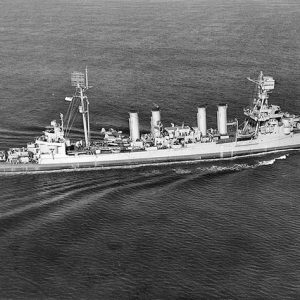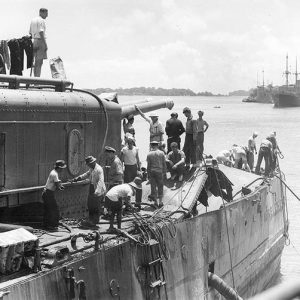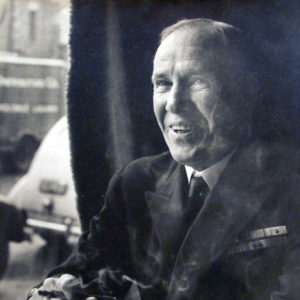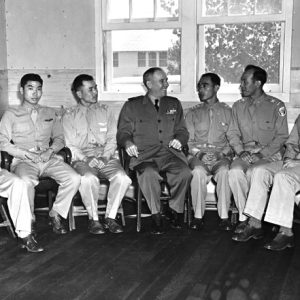calsfoundation@cals.org
Corydon McAlmont Wassell (1884–1958)
Rear Admiral Corydon McAlmont Wassell was one of the first national heroes of World War II. His service for the United States in early 1942 earned him the Navy Cross and praise from President Franklin D. Roosevelt, and his story inspired a movie starring Gary Cooper.
Cory Wassell was born on July 4, 1884, in Little Rock (Pulaski County), the son of Albert and Leona Wassell of Little Rock. He studied medicine at the University of Arkansas Medical School (now the University of Arkansas for Medical Sciences), where he obtained a medical degree in 1909. He did postgraduate work at Johns Hopkins University. After graduation, he practiced in Tillar (Desha and Drew counties) for a short time. Wassell married a local woman, Mary Irene Yarnell, on December 27, 1911. They had four children.
In 1914, the Wassells volunteered as medical missionaries after hearing a lecture in the local Episcopal church on the medical needs of the Chinese people. They were posted to the Wauchang area of China and served there for the next twelve years. After Mary’s death in China on May 28, 1926, Wassell married Madeline Edith Day, whom he met on the mission field at Wauchang.
Wassell applied for a commission in the U.S. Navy and was made provisional lieutenant in the reserves in 1926 but did not immediately see active duty. In 1927, he and his second wife returned to Arkansas, where Wassell worked in public health at various locations, primarily as a doctor for the Civilian Conservation Corps (CCC), treating malaria and other diseases among the workers. Then, in 1936, he was called to active duty in the navy and stationed in Key West, Florida.
In October 1941, Wassell received new orders to report to the Philippines. He was to leave San Francisco for this new post on December 7, 1941, but in light of the Japanese attack on Pearl Harbor, his ship was rerouted to Java in the Netherlands East Indies (now Indonesia).
On February 4, 1942, the cruisers USS Houston and USS Marblehead were badly damaged by Japanese forces. The ships docked in Java for repair, and sailors needed medical attention. Wassell was detailed to work with the allied Dutch medical personnel already on the island, taking charge of the American sailors’ medical care.
In February 1942, the British fortress of Singapore fell, and the Japanese invaded Sumatra in the Netherlands East Indies. Orders were issued for all Americans to evacuate. Due to extreme conditions of overcrowding on transport vessels, the Navy restricted transport of wounded to those who could walk. Though Wassell tried to get an exception made for a group of non-ambulatory patients, they were turned away. Wassell himself was offered the chance to leave Java but declined, electing to stay with his patients, knowing that he would be captured by the enemy. Wassell was “almost like a Christ-like shepherd devoted to his flock,” President Franklin Roosevelt told the nation on the evening of April 29, 1942, in his forty-ninth fireside chat.
Wassell returned with the men to a hospital near Yogyakarta in East Java, Indonesia, prepared to endure the worst. However, as the Japanese army was closing in, Wassell persuaded a British army convoy to give them transportation to the coast, where he hoped to find a ship that might be willing to take them. Wassell took a vote among the men, and all agreed that they should make the grueling effort. Under extremely hazardous and trying conditions, Wassell transported about a dozen severely injured men approximately 150 miles (200 km) over rough jungle roads to the southern port of Tjilatjap. With only medical skill and limited resources at his command, Wassell undertook to ease the suffering of these men while in the transport and was able to get all but one of the men to the coast for evacuation.
In Tjilatjap, Wassell talked the reluctant Dutch captain of the Jannsens into taking them aboard. Overloaded, the Jannsens moved with great difficulty and came under Japanese attack several times. As President Roosevelt noted, “Dr. Wassell took virtual command of the ship, and by great skill avoided destruction in the bays and little inlets.” After a tense ten-day voyage, the Jannsens docked in Australia. The official citation for Wassell’s Navy Cross notes, “Lieutenant Commander Wassell disregarded personal safety while caring for and evacuating wounded…under extremely trying conditions. By his courage, determination and untiring devotion to duty, Lieutenant Commander Wassell saved many lives.”
Wassell became an instant international hero. Author James Hilton wrote a biography of him, called simply The Story of Dr. Wassell (1943). Producer Cecil B. DeMille, hearing Roosevelt’s fireside chat, acquired the rights to the book to make a movie of the same name. Starring Gary Cooper, The Story of Dr. Wassell was released in 1944. It was a highly fictionalized account, and Wassell later joked about the film being the only real cause of his fame.
After retiring from the navy with the rank of rear admiral, Wassell worked for a time without pay at a charity hospital in Hawaii. He eventually returned to Key West, Florida. Later, he returned to Arkansas to be near family. He died on May 12, 1958, in Little Rock at the age of seventy-four. He is buried at Arlington National Cemetery.
For additional information:
Hilton, James. The Story of Dr. Wassell. New York: Little, Brown & Co., 1943.
Hull, Michael. “Profiles.” World War II History Magazine. May 2006, p. 14.
Sobocinski, Andre B. “Corydon Wassell: A Missionary for All Seasons.” Navy Medicine 95 (March–April 2004): 25.
USS Marblehead & Dr. Wassell Information Center. http://www.ussmarblehead.com (accessed April 29, 2022).
David O. Bowden
Little Rock, Arkansas
 USS Marblehead
USS Marblehead  USS Marblehead
USS Marblehead  Corydon Wassell
Corydon Wassell  Corydon Wassell
Corydon Wassell 




I saw the movie The Story of Dr. Wassell about the time it was released in 1944. I was greatly impressed with Dr. Wassells service in the U.S. Navy in World War II. Then in the spring of 1949, I had the honor of meeting Dr. and Mrs. Wassell in person. They came through my checkout stand at the Kroger store in DeWitt, Arkansas, after shopping for groceries. Mrs. Wassell wrote a check for their purchase, and I noted the name on the check. I happened to mention that I knew about a naval hero of World War II, and I asked if they were related to that Dr. Wassell. Dr. Wassell replied, I am that Dr. Wassell. That just happened to be the one and only time I had ever met a real American hero and was very excited to say the least. My wife and I were visiting St. Charles, Arkansas, many years later and we located the house where the Wassells had lived in the late 1940s. I now have a copy of the movie The Story of Dr. Wassell and have reviewed it several times. I still am fascinated about that story and remember shaking hands with my hero Dr. Wassell.